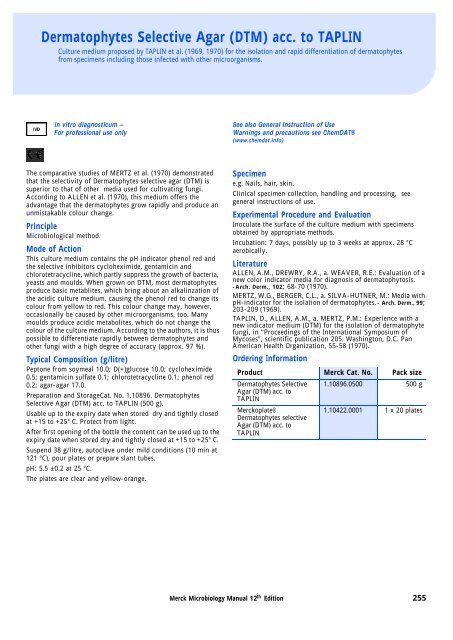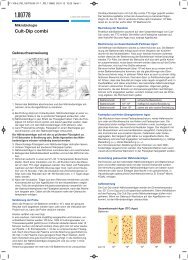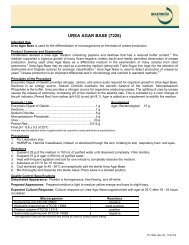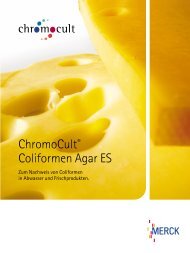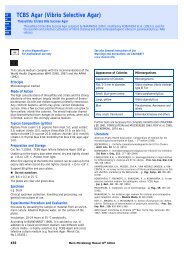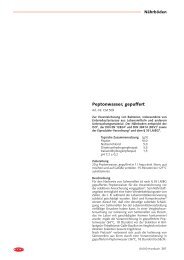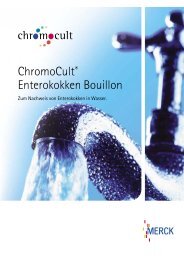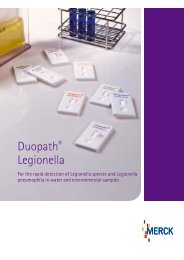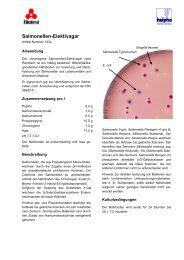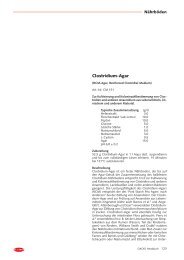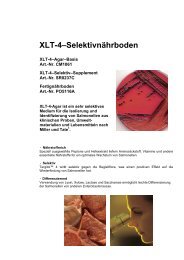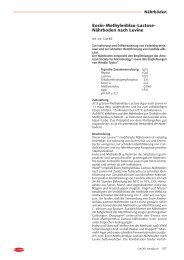Dermatophytes Selective Agar (DTM) acc. to TAPLIN - mibius
Dermatophytes Selective Agar (DTM) acc. to TAPLIN - mibius
Dermatophytes Selective Agar (DTM) acc. to TAPLIN - mibius
- No tags were found...
You also want an ePaper? Increase the reach of your titles
YUMPU automatically turns print PDFs into web optimized ePapers that Google loves.
<strong>Derma<strong>to</strong>phytes</strong> <strong>Selective</strong> <strong>Agar</strong> (<strong>DTM</strong>) <strong>acc</strong>. <strong>to</strong> <strong>TAPLIN</strong>Culture medium proposed by <strong>TAPLIN</strong> et al. (1969, 1970) for the isolation and rapid differentiation of derma<strong>to</strong>phytesfrom specimens including those infected with other microorganisms.<strong>Derma<strong>to</strong>phytes</strong> <strong>Selective</strong> <strong>Agar</strong> (<strong>DTM</strong>) <strong>acc</strong>. <strong>to</strong> <strong>TAPLIN</strong>in vitro diagnosticum –For professional use onlySee also General Instruction of UseWarnings and precautions see ChemDAT®(www.chemdat.info)The comparative studies of MERTZ et al. (1970) demonstratedthat the selectivity of <strong>Derma<strong>to</strong>phytes</strong> selective agar (<strong>DTM</strong>) issuperior <strong>to</strong> that of other media used for cultivating fungi.According <strong>to</strong> ALLEN et al. (1970), this medium offers theadvantage that the derma<strong>to</strong>phytes grow rapidly and produce anunmistakable colour change.PrincipleMicrobiological method.Mode of ActionThis culture medium contains the pH indica<strong>to</strong>r phenol red andthe selective inhibi<strong>to</strong>rs cycloheximide, gentamicin andchlorotetracycline, which partly suppress the growth of bacteria,yeasts and moulds. When grown on <strong>DTM</strong>, most derma<strong>to</strong>phytesproduce basic metablites, which bring about an alkalinzation ofthe acidic culture medium, causing the phenol red <strong>to</strong> change itscolour from yellow <strong>to</strong> red. This colour change may, however,occasionally be caused by other microorganisms, <strong>to</strong>o. Manymoulds produce acidic metabolites, which do not change thecolour of the culture medium. According <strong>to</strong> the authors, it is thuspossible <strong>to</strong> differentiate rapidly between derma<strong>to</strong>phytes andother fungi with a high degree of <strong>acc</strong>uracy (approx. 97 %).Typical Composition (g/litre)Pep<strong>to</strong>ne from soymeal 10.0; D(+)glucose 10.0; cycloheximide0.5; gentamicin sulfate 0.1; chlorotetracycline 0.1; phenol red0.2; agar-agar 17.0.Preparation and S<strong>to</strong>rageCat. No. 1.10896. <strong>Derma<strong>to</strong>phytes</strong><strong>Selective</strong> <strong>Agar</strong> (<strong>DTM</strong>) <strong>acc</strong>. <strong>to</strong> <strong>TAPLIN</strong> (500 g).Usable up <strong>to</strong> the expiry date when s<strong>to</strong>red dry and tightly closedat +15 <strong>to</strong> +25° C. Protect from light.After first opening of the bottle the content can be used up <strong>to</strong> theexpiry date when s<strong>to</strong>red dry and tightly closed at +15 <strong>to</strong> +25° C.Suspend 38 g/litre, au<strong>to</strong>clave under mild conditions (10 min at121 °C), pour plates or prepare slant tubes.pH: 5.5 ±0.2 at 25 °C.The plates are clear and yellow-orange.Specimene.g. Nails, hair, skin.Clinical specimen collection, handling and processing, seegeneral instructions of use.Experimental Procedure and EvaluationInoculate the surface of the culture medium with specimensobtained by appropriate methods.Incubation: 7 days, possibly up <strong>to</strong> 3 weeks at approx. 28 °Caerobically.LiteratureALLEN, A.M., DREWRY, R.A., a. WEAVER, R.E.: Evaluation of anew color indica<strong>to</strong>r media for diagnosis of derma<strong>to</strong>phy<strong>to</strong>sis.-Arch. Derm., 102; 68-70 (1970).MERTZ, W.G., BERGER, C.L., a. SILVA-HUTNER, M.: Media withpH-indica<strong>to</strong>r for the isolation of derma<strong>to</strong>phytes. - Arch. Derm., 99;203-209 (1969).<strong>TAPLIN</strong>, D., ALLEN, A.M., a. MERTZ, P.M.: Experience with anew indica<strong>to</strong>r medium (<strong>DTM</strong>) for the isolation of derma<strong>to</strong>phytefungi, in "Proceedings of the International Symposium ofMycoses", scientific publication 205. Washing<strong>to</strong>n, D.C. PanAmerican Health Organization, 55-58 (1970).Ordering InformationProduct Merck Cat. No. Pack size<strong>Derma<strong>to</strong>phytes</strong> <strong>Selective</strong><strong>Agar</strong> (<strong>DTM</strong>) <strong>acc</strong>. <strong>to</strong><strong>TAPLIN</strong>Merckoplate®<strong>Derma<strong>to</strong>phytes</strong> selective<strong>Agar</strong> (<strong>DTM</strong>) <strong>acc</strong>. <strong>to</strong><strong>TAPLIN</strong>1.10896.0500 500 g1.10422.0001 1 x 20 platesMerck Microbiology Manual 12 th Edition 255
<strong>Derma<strong>to</strong>phytes</strong> <strong>Selective</strong> <strong>Agar</strong> (<strong>DTM</strong>) <strong>acc</strong>. <strong>to</strong> <strong>TAPLIN</strong>Quality control (incubation: 7 days at 28 °C, aerobic)Test strains Growth Colour change <strong>to</strong> redTrichophy<strong>to</strong>n mentagrophytes ATCC 18748 poor / good +Trichophy<strong>to</strong>n rubrum ATCC 28188 poor / good +Microsporum gallinae ATCC 12108 poor / good +Microsporum canis ATCC 36299 poor / good +Geotrichum candidum DSMZ 1240 fair / good ±Candida albicans ATCC 10231 good / very good +Aspergillus niger ATCC 16404none / poorPenicillium commune ATCC 10428none / poorS<strong>acc</strong>haromyces cerevisiae ATCC 9763noneBacillus cereus ATCC 11778noneEscherichia coli ATCC 25922noneStaphylococcus aureus ATCC 25923noneCandida albicansATCC 10231Geotrichum candidumDSMZ 1240256 Merck Microbiology Manual 12 th Edition


